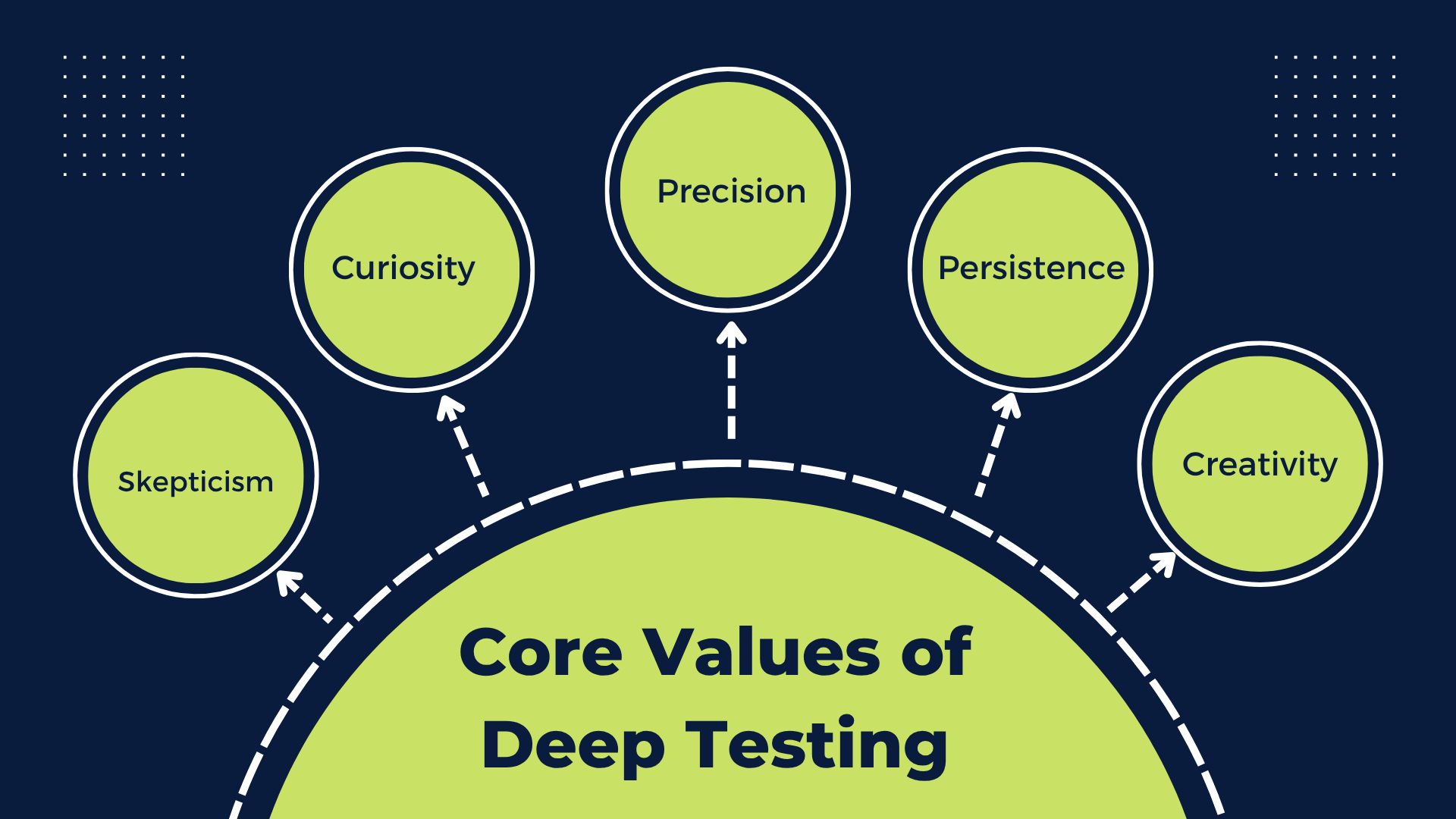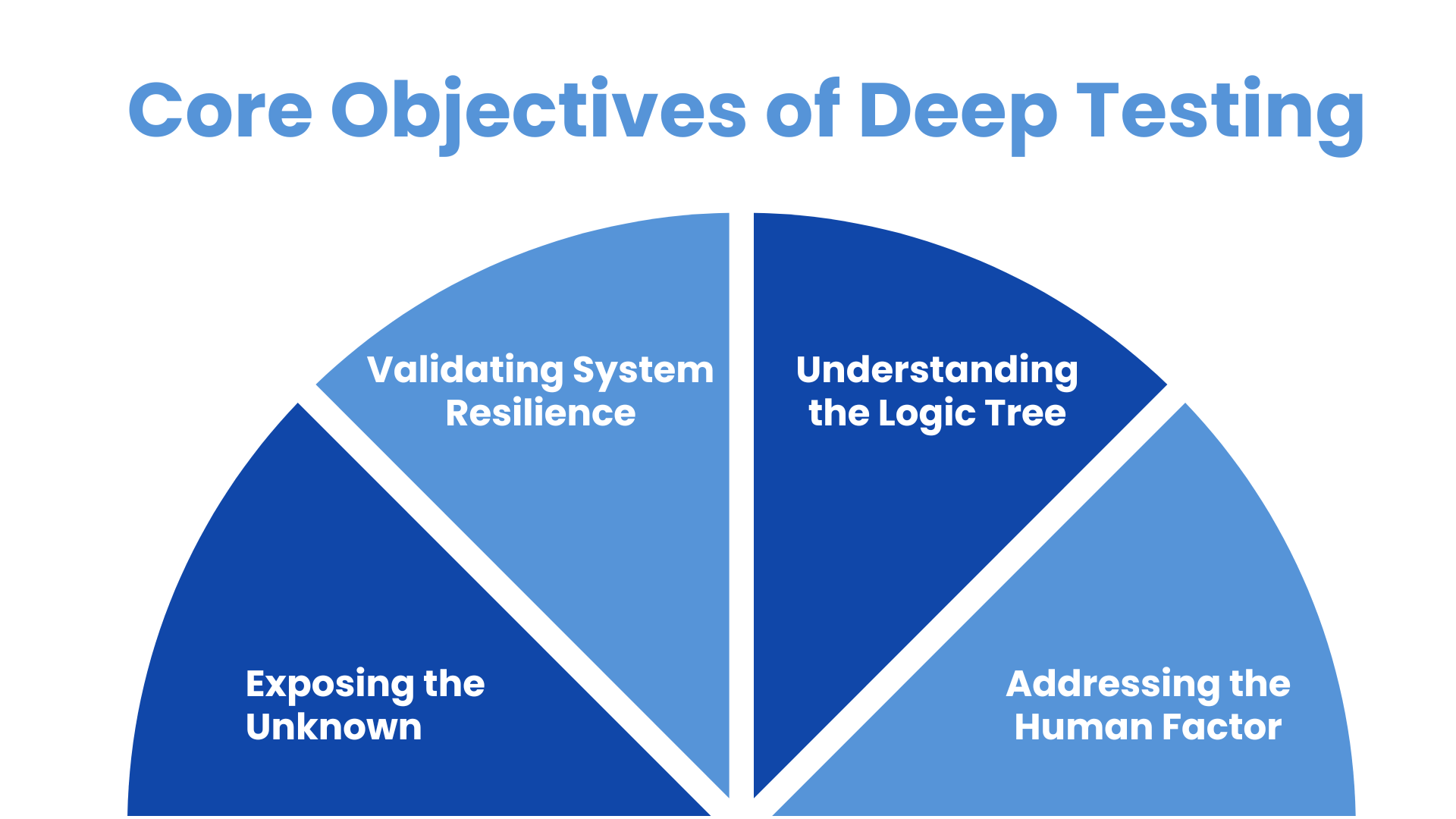What is Deep Testing?
|
|
Within the constantly evolving culture of software development, testing has become more than just simple “checks” of expected behaviors. It has grown into a process of complex verifications of system real-world preparedness. Deep testing is, among the arsenal of testing strategies, particularly noted for its thoroughness and focus on uncovering essential issues that other approaches may overlook.
Deep testing isn’t merely thoroughness; it’s depth, precision, and insight. Where breadth testing is concerned with getting the most coverage for the most scenarios as fast as possible, ramping up from low-level implementations, deep testing focuses on a small set of functionality and illuminates it in every possible way.
| Key Takeaways: |
|---|
|

What is Deep Testing?
Deep testing is the term used to describe a systematic, thorough, and investigative approach to testing in depth rather than in breadth. It is employed to validate very small functionality, but in a very rigorous manner. From this point of view, depth is that each test probes to understand not only what a feature does, but also why it works, why it doesn’t, what it assumes about other systems or contexts, and how it interacts with other systems or variables.
Deep testing attempts to discover latent bugs that are not necessarily exposed by everyday validation, by running the system to its limits and observing how it behaves under stress, at the edge (of input, of resources, of sanity), at a failure. But it’s not just about confirmation either—it’s about exploration, challenge, and deep understanding of how and why the software behaves as it does.
Why Deep Testing in Software Matters
The modern software development world is full of unknowns: concurrent systems, third-party integrations, machine learning models, microservices, event-driven architectures, to name a few. These are systems that are subject to rare and hard-to-reproduce issues that don’t always show up during normal testing.
As information systems are increasingly composed of poorly understood and unstable collections of software components, the chance for subtle flaws and elusive failures explodes. Inter-service dependencies, timing, and asynchrony can yield bugs that are all but impossible to find with superficial testing. Without delving further into these nuances, critical failures could easily fly beneath the radar until they have the potential to do real-world harm.
- A banking app may pass all basic tests but fail under concurrent fund transfers across time zones.
- A medical device might crash when sensor data arrives out of order.
- An e-commerce recommendation engine might display inappropriate suggestions due to unusual combinations of user behavior.
These types of issues often only surface through deep testing, where the test design aims to break assumptions and mimic real-world anomalies.
The Philosophy Behind Deep Testing
Deep testing is more than a method; it is a philosophy based on curiosity, skepticism, and technical expertise. It prioritizes wonder over affirmation, and comprehension over assumption. It asks testers to approach problems as detectives probing for the unexpected. Deep testing is less about confirming the anticipated and more about testing the system against unexpected and potentially unprecedented conditions.
Core Values of Deep Testing

- Skepticism: Start with the working assumption that the system is going to be broken in some way that has not yet been found, so that you must validate the system.
- Curiosity: Continuously ask probing questions like “What happens if?” or “Why does it behave this way?” to explore system behaviors beyond the obvious.
- Precision: Test with the exact, well-chosen inputs and conditions needed to reveal subtle bugs that general or broad tests might not detect.
- Persistence: You keep testing with weird inputs, corner cases, and random conditions until you are pretty sure that your code can handle real-world complexity.
- Creativity: Imagine all sorts of user interactions that might occur and the odd situations that could stress a system, even when it’s working normally.
This is very different from ‘checkbox’ style testing, where you simply tick off (or not) boxes of expected behaviour. Deep testing is not afraid of what-ifs, edge cases, or murky system behaviors.
Core Objectives of Deep Testing

The essence of deep testing is not to validate that software does work, but to explore its stability, resilience, and assumptions as applied in a range of contexts. It’s centered on revealing flaws that everyday testing does not catch, particularly ones hidden in edge cases, unseen logic paths, or intricate system interactions.
The following are the primary goals of deep testing initiatives.
Exposing the Unknown
Deep testing aims to find hidden behaviors and bugs that are not discovered through standard testing. It detects undocumented features, unintended side-effects, and deeply buried bugs that only appear under unusual or extreme circumstances. By delving into these unknowns, deep testing can expose issues that might not emerge until after a release is shipped.
Validating System Resilience
A key aspect of deep testing is to understand the behavior of systems when they are in failure or under stress. Systems can’t just work for the best-case scenario; they need to be fault-tolerant, informative when breaking down, and respectful of users’ data. Profound tests mean complex things like crashes, exceptions, or network issues are handled in a predictable manner and don’t compromise the user experience.
Understanding the Logic Tree
Applications frequently have complex lattices of decision logic, branching pathways, and condition-based workflow. This kind of deep testing helps map and evaluate these logic trees, indeed every path, especially those more unusual or conditional ones, so that they all work as they are supposed to. This is especially important for mission-critical applications such as financial engines, AI-powered models, or automated approval workflows.
Addressing the Human Factor
Actual users often don’t adhere to the ideal usage pattern; they do the wrong thing, act unpredictably, or enter data in strange formats. Deep testing emulates this human variability with random user actions, typos, incomplete steps, misuse patterns, and more. In doing so, it enhances system tolerance, usability, and robustness against human-related faults.
Deep Testing vs. Other Testing Types
Deep testing often intersects with other testing approaches but differs in its purpose and depth. It’s not just about testing to make sure things work, but about really reaching in and seeing what can be broken, when, and why. Whereas conventional testing mechanisms tend to concentrate on known behaviors, deep testing performs optimally in uncertainty; stressing the edges of a system enables deep testing to reveal some of the most critical flaws that other methods might overlook.
| Testing Type | Purpose | Depth | Breadth | Real-world Simulation | Risk Detection |
|---|---|---|---|---|---|
| Unit Testing | Validate individual methods | High (but narrow) | Low | Low | Low |
| Functional Testing | Verify business features | Medium | Medium | Medium | Medium |
| Breadth Testing | Cover many features quickly | Low | High | Low | Low |
| Regression Testing | Detect bugs from recent changes | Medium | Medium | Low | Medium |
| Exploratory Testing | Discover unknown issues | Medium-High | Medium | High | High |
| Deep Testing | Challenge system assumptions and expose edge case issues | Very High | Low | Very High | Very High |
Techniques and Approaches Used in Deep Testing
Deep testing is a multidisciplinary approach that goes beyond traditional test approaches, and tries to put the system under stress to see hidden unwanted behaviors. These techniques are partially extracted to reproduce edge cases, rare situations, and faults that will appear under certain conditions only, leading to the assurance of software reliability under stress.
Boundary and Range Testing
Boundary and range testing concentrates on testing inputs that are at the borders or limits of valid and invalid inputs, and which are often forgotten during normal testing. Such tests are critical in uncovering off-by-one, rounding, and buffer overrun problems.
Example: If a text field can hold a maximum of 50 characters, test it with 49, 50, 51, and 100 characters to see how the system responds.
State-Based Testing
This method measures how the system behaves when transitioning from one internal state to another and guarantees that changes are appropriately handled. It also checks whether the system can resume after interruptions or has repetitive equivalent behaviour. Read more: What is State Transition Testing?
Example: In an online order system, test scenarios such as moving from “Payment Pending” to “Payment Failed” and back to “Payment Retried.”
Decision Table Testing
Decision table testing is focused on systems that involve a combination of rules/conditions, and each rule/condition interacts with the others in a complex manner. It even guarantees that all significant sets of inputs are being tested for logical correctness and unintended overlaps or gaps. Understand more: Decision Table in Software Testing.
Example: While testing a loan approval system, you might combine tests based on income, credit score, employment status, and age to verify that eligibility decisions are correct.
Timing and Delay Testing
This method introduces artificial timing variations, race conditions, or asynchronous execution to expose concurrency and synchronization bugs. It enables you to detect problems that exist only when certain events happen concurrently or out of sequence.
Example: Simulate two users placing an order for the last item in stock at the exact same time to test if the inventory system handles it correctly.
Environmental Variation Testing
Environmental variance testing includes examining the application’s behavior in different system environments, such as other OS versions and time zones or with different network conditions. This helps to unveil location-specific, configuration-dependent or locale-generated problems. Read more: Managing Your Test Environment: What You Need to Know.
Example: Set the device’s language to Japanese and time zone to UTC+9, check if date formatting and app translations work properly.
Deep Testing in Different Software Testing Phases
Deep testing can be used successfully in all stages of the software test life cycle, ranging from the smallest pieces of code to whole systems being tested. By adding depth to each phase, teams can catch subtle defects early, validate complicated interactions, and confirm that the application behaves properly under a variety of conditions and use cases.
During Unit Testing
At the unit testing level, developers typically focus on verifying expected inputs and straightforward logic paths. Deep testing, however, expands the scope by introducing unexpected or extreme inputs such as incorrect data types, null values, negative numbers, recursive edge conditions, and buffer overflows to uncover hidden weaknesses or unsafe operations in the code. This helps ensure that even isolated functions remain robust under unpredictable scenarios.
During Integration Testing
At the integration level, when modules or services work together, we need to verify these interactions under load, and deep testing is necessary. By simulating scenarios such as database lock contention, mid-session API failures, components crashing during data handoff, or out-of-order collection of events, testers can make sure that the interfaces between various components are robust under less-than-ideal conditions.
During System Testing
System level deep testing involves testing how your full application behaves under realistic and extreme conditions. This involves things like simulating load spikes to test scalability, simulating database corruptions to validate error handling, running for long periods of time without offlining data or restarting work and triggering recovery flows from system-level failures e.g., disk full or network outage. This kind of testing is used to validate end-to-end resilience and disaster recovery capability.
During Acceptance Testing
While UAT naturally focuses on verifying experience/business requirements, deep testing can add a realistic flavour of unpredictability of human behavior into the application. This includes special attention to and exploration of the non-standard workflow paths, skipping the important steps deliberately (like closing without saving), emulating the mistakes of the real user, and using more than one tester at the same time with high concurrency. These tests assure that such a system gracefully supports real-world usage practices, even those that go off the beaten path.
Common Pitfalls and How to Avoid Them
Deep testing is a great way to reveal hidden problems, but it has its own issues to overcome. When not handled correctly, it can also be inefficient, mind-numbing and worst still, counter-productive.
Here are some common traps to help you get the most out of deep testing without accidentally messing everything up.
Pitfall 1: Testing Everything with Equal Depth
Trying to test everything in an app deep can be too time-consuming and/or yield less benefit. The same level of diligence is not needed for every part, and spreading resources in too many directions may result in overlooking critical defects in high-risk regions.
Solution: Use risk-based testing to focus on deeper testing for complex, business-critical, customer-facing features. Concentrate on failing only where failure is least tolerable.
Pitfall 2: Overloading Test Infrastructure
Deep tests frequently require large amounts of data, concurrency, and long execution, which can stress your test environment or slow down the CI/CD pipeline. This can result in timeouts, reserved resources, and slower feedback.
Solution: Make sure you have enough resources on your test infrastructure to run those highly intensive tests, and that they are well configured. You can try running deep test suites in times that are not peak times or, if feasible, independent of faster sanity/regression checks.
Pitfall 3: False Positives and Flaky Tests
Deep tests can invoke complex behaviors and race conditions and may return flaky or inconsistent results. This can lead to a loss of faith in your test suite and potentially result in critical issues being missed.
Solution: Write some retry logic, write slightly more intelligent assertions that deal with timing variance, and don’t allow side effects to seep into your tests. Spend the time to stabilize (make reliable) flaky tests, and keep them in check.
Deep Testing as a Cultural Mindset
Deep testing is, in fact, more than merely a technical activity; it’s a mindset. It takes a mindset that treasures creativity, resilience, and the courage to question assumptions. Companies that cultivate deep testing as a cultural trait tend to create more reliable and robust software, as they are focused not only on creating features but also on creating them well.
Cultivating Deep Testers
Deep testers have some mix of personality and professional traits that tell them to see what is really there, and not just readily apparent. They are also (naturally) distrustful of things, always wondering if the software really works in every scenario. Most originate in fields like security testing, systems engineering or domain-specific analysis, where failure is not an option, and precision is paramount.
Creating a Deep Testing Culture
Creating a culture of deep testing is not about checking off a traditional QA reading list. Organizations should incentivize finding bugs and value flaw-finding as a contribution. Deep testing should be technical craftsmanship, a skilled, mindful practice, not a procedural job. When this is adopted, deep testing becomes a legitimate, accepted part of development.
Final Thoughts
Deep testing isn’t easy; it takes time, patience, and an obsessive focus on the details. It is sometimes difficult and even frustrating, but the reward is well worth it. By discovering nuanced bugs, latent vulnerabilities, and edge-case crashes, deep testing prevents the catastrophic issues that can cause outages, security breaches, and loss of user trust.
No longer should you be asking, “Does it work?” in a world where software systems are expected to function flawlessly under pressure. We should be asking the more essential question: “Will it continue to work when it counts?”
That’s the essence and the enduring promise of deep testing.
| Achieve More Than 90% Test Automation | |
| Step by Step Walkthroughs and Help | |
| 14 Day Free Trial, Cancel Anytime |












